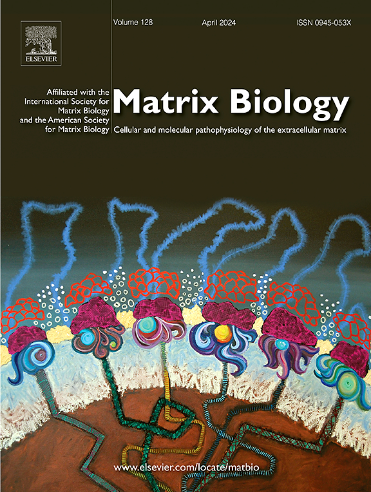Heparan sulfate N-deacetylase/N-sulfotransferase-1 regulates glioblastoma cell migration and invasion
IF 4.8
1区 生物学
Q1 BIOCHEMISTRY & MOLECULAR BIOLOGY
引用次数: 0
Abstract
The glioblastoma (GBM) microenvironment undergoes adaptations to support tumor progression, including a dysregulated extracellular matrix, with altered heparan sulfate (HS) proteoglycans. We investigated N-deacetylase/N-sulfotransferase-1 (NDST1) because NDSTs are initial modifying enzymes of HS biosynthesis and have key roles in designing the HS sulfation pattern. This, in turn governs interactions with growth factors and other biomolecules. We report that NDST1 expression is lower in GBM than in the normal brain, and that patient-derived GBM cells, grown under neural stem cell culture conditions have lower levels of HS than normal astrocytes. Overexpression of NDST1 in GBM cells with low inherent NDST1 levels stimulates cell migration, reduce cell adhesion, induce EMT markers and increase invasion. Conversely, when NDST1 levels were reduced by shRNA in GBM cells, that had higher baseline expression, we find that invasion is reduced, and instead, self-renewal capacity increases alongside elevated stem cell marker expression. Moreover, overexpression of NDST1 changes chromatin accessibility of gene regulatory regions with the capacity to affect transcription factor expression, and pathways that favors cell motility and invasion. Furthermore, NDST1 overexpression results in increased activation of several receptor tyrosine kinases. This study shows that low NDST1 levels support GBM cell stemness, whereas high NDST1 levels endow tumor cells with a motile cell phenotype. We therefore propose that NDST1 is important for regulation of the balance between proliferation and invasive properties in GBM cells.
硫酸乙酰肝素n -去乙酰化酶/ n -硫转移酶-1调控胶质母细胞瘤细胞的迁移和侵袭。
胶质母细胞瘤(GBM)微环境经历适应以支持肿瘤进展,包括细胞外基质失调,硫酸肝素(HS)蛋白聚糖改变。我们研究了n -去乙酰化酶/ n -硫转移酶-1 (NDST1),因为NDST1是HS生物合成的初始修饰酶,在设计HS磺化模式中起关键作用。这反过来又控制着与生长因子和其他生物分子的相互作用。我们报道了NDST1在GBM中的表达低于正常大脑,并且在神经干细胞培养条件下生长的患者来源的GBM细胞的HS水平低于正常星形胶质细胞。NDST1在固有NDST1水平较低的GBM细胞中过表达,可刺激细胞迁移,降低细胞粘附,诱导EMT标志物,增加侵袭。相反,当具有较高基线表达的GBM细胞中的NDST1水平被shRNA降低时,我们发现侵袭减少,相反,自我更新能力随着干细胞标记物表达的升高而增加。此外,NDST1的过表达改变了基因调控区域的染色质可及性,从而影响转录因子的表达,以及有利于细胞运动和侵袭的途径。此外,NDST1过表达导致几种受体酪氨酸激酶的激活增加。该研究表明,低NDST1水平支持GBM细胞的干性,而高NDST1水平赋予肿瘤细胞运动细胞表型。因此,我们认为NDST1在GBM细胞增殖和侵袭特性之间的平衡调节中很重要。
本文章由计算机程序翻译,如有差异,请以英文原文为准。
求助全文
约1分钟内获得全文
求助全文
来源期刊

Matrix Biology
生物-生化与分子生物学
CiteScore
11.40
自引率
4.30%
发文量
77
审稿时长
45 days
期刊介绍:
Matrix Biology (established in 1980 as Collagen and Related Research) is a cutting-edge journal that is devoted to publishing the latest results in matrix biology research. We welcome articles that reside at the nexus of understanding the cellular and molecular pathophysiology of the extracellular matrix. Matrix Biology focusses on solving elusive questions, opening new avenues of thought and discovery, and challenging longstanding biological paradigms.
 求助内容:
求助内容: 应助结果提醒方式:
应助结果提醒方式:


